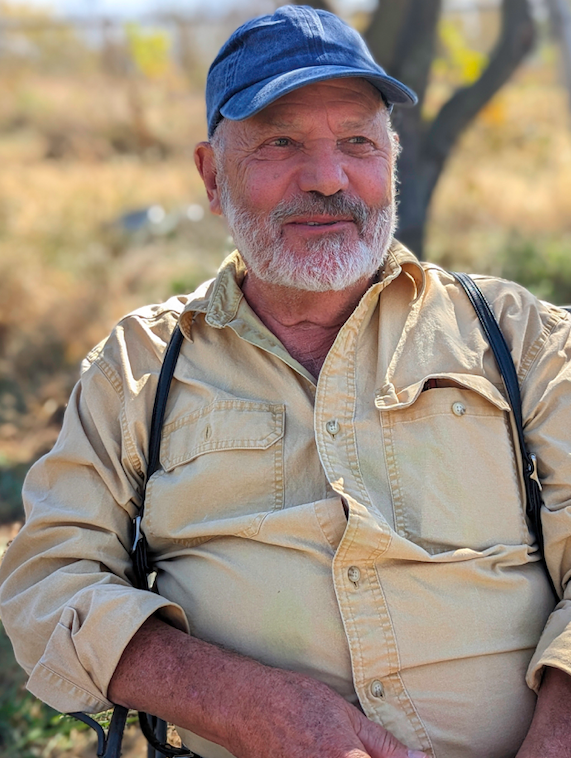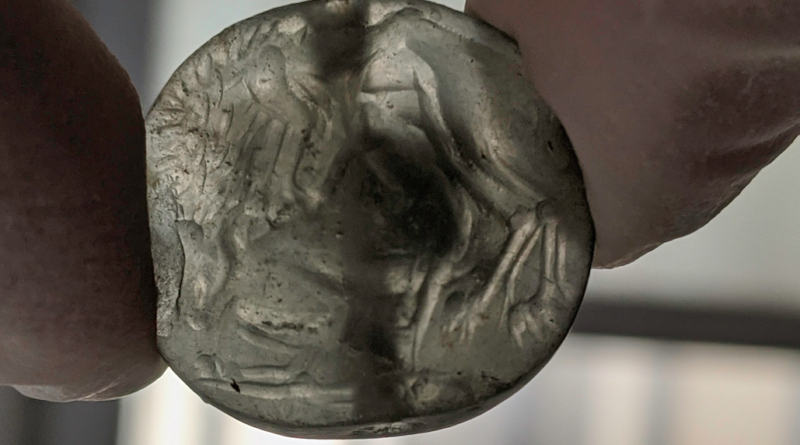INTERVIEW: Was Odysseus real? This seal stone may offer some clues.
Photo: The seal stone becomes an important artifact in the search for Odysseus. Photo courtesy of PBS / Provided by press site with permission.
The new PBS special Odysseus Returns, which premiered Aug. 28 and is available to stream at PBS.org or on the PBS app, delves deep into the story of Homer’s Odyssey, the epic poem that charts the travails of King Odysseus as he makes his way home from war. This TV program asks whether Odysseus was based on a real person or a fictional creation of Homer.
At the center of the academic question is Dr. John Younger, an emeritus professor at the University of Kansas’ classics department and co-director of the film with Seth Ward. The film follows several characters throughout this inquiry, including Makis Mataxas, who is billed as an amateur historian who believes he discovered Odysseus’ tomb on the island of Kefalonia. The tomb appears to belong to a 3,000-year-old Mycenaean king, but which king exactly is part of the academic pursuit of Mataxas, Younger and others involved in this mystery.
A curious and convincing object found at the burial site transformed this debate. A seal stone was found at the tomb that almost perfectly tracks with a seal stone described by Homer in the story. Younger is an expert on these stones and offered his insights on the importance of this discovery. Questions and answers have been slightly edited for style.
On whether King Odysseus was an historical figure …
YOUNGER: “I feel that there is no definitive evidence, but I’ll say this, if Odysseus wasn’t real, in a sense, we have to make him up in order to make sense of it all. There are quite a few instances in Homer — I would say maybe 10-15 — where Homer says something, and we actually have a piece of evidence that that kind of thing did exist back then. I think a really good one, this seal that you’re interested in, is one of those rather remarkable coincidences where Homer describes that Odysseus had a brooch or something. I would call it a belt buckle, and on the belt buckle, there was a lion attacking a deer. Well, we’ve got that seal. It is exactly the way Homer describes it, even to the point where the deer is one of these … deer with very long ears and is contorted. Homer says he was writhing to get free, and let’s say it’s not totally unique, totally convincing, but it’s pretty darn close. And Homer has a couple of other instances where he talks about Nestor, the king of Pylus, having a gold cup with doves on either side of the cup on the rim, and we have one of those. It’s unique. How did Homer know about this?
On where the seal stone was found …
YOUNGER: “That was found not only at the tomb, but also on the chest of the principal guy that was buried there. Several other seals were found in and around the body, but this particular one was found basically on the chest as if it were a necklace or something or a pendant.”
On the purpose of seal stones …
YOUNGER: “Well, it had two major purposes. One was a personal possession to identify you as a member of the general society, so everybody in Greece had a seal stone of some quality or another. And the functional thing is that when you paid your taxes, which you did in kind, you sent agricultural products to the palace. You would bind that up. … Tomatoes is a good thing. Say you wrapped the tomatoes up, and you put twine around that to keep it as a package. And then you put clay over the knot of the twine. Then you take this seal stone, which has an artistic representation done into the stone. … And you press that on to the clay, and, of course, the result now comes out at you in relief. That basically would then certify that you have paid your taxes. You send that in with your wrapped tomatoes, and when it gets to the palace, they rip off the clay sealing. And they keep that as a record that you have paid your taxes, so there is a functional thing identifying you as a person in a society, but also identifying you as a contributor to the administration in some way.”
On the 1991 discovery and subsequent excavation of the tomb in question …
YOUNGER: “I got to know the excavator [Lazaros Kolonas] who was actually not there at the time when the seal stone was found. He was in central Greece, but there is a local guy named Mataxas. And this local guy is like many, many Greeks. They know everything about the geography, the history and what goes on, and this local guy knew of the … tomb. And I don’t think he participated in the excavation, but he was there every day. And he certainly talked to the excavator when the excavator was there. As I said, [the excavator] wasn’t there at the time that the seal stone was found, but this guy, Mataxas, was there. This guy is very typical of local Greeks who get really, really interested in the local area. … He didn’t participate in the excavations, but he was there every day in order to find out what’s going on. And I got to know him real well. He was a very interesting guy, former mayor of his village, and he had brought electricity to his village, so on and so forth. He was quite a mover and shaker in his local way, so I talked to him about how the seal stone was found.”
On what the tomb looks like today …
YOUNGER: “[The seal stone] was found in a tomb that’s like a gigantic beehive, maybe 30 feet in diameter and about 30 feet tall, a vaulted tomb, and this thing had collapsed. It just fell in on itself, so it was very easy to see. This guy, Mataxas, knew about it, knew that the tomb was there because it had collapsed. It’s now kind of a dished hollow in the ground, and they called in the excavator. Now the excavator is a bureaucrat who was in charge of archaeological activity on the island of Kefalonia. He had the right to excavate, and so he did. But he didn’t himself know what he was excavating. This was not his specialty, and what they basically found … on the floor in the center of it was a stone-built chest, a cyst. And in that was the deceased, this burial, and on his chest was a seal stone. This seal stone is a rather peculiar greenish transparent-like quartz. I’ve never seen anything like it, and that’s one of the things that really intrigued me about it. And around him were maybe 10 other seal stones made of a very common soft material that you could gouge with a pen knife, but this quartz thing, you have to know your business in how to carve that. That would be difficult. I basically talk about these things as if there are soft stones that you can carve with a knife, and then there are hard stones that you really have to work at. This is one of those hard stones where you really had to work at it. We spent about three days in and around the tomb. I had gotten permission from the authorities to examine the seal stone where it was being housed, in a kind of warehouse type of thing, so I traveled there. And they’ve got the seal stone out. I was able to take a look at it up close with a magnifying glass with special lights and cameras and take photographs and so on and so forth. … I also took plasticine impressions of the seal stone that was on his chest.”
On whether this seal stone ultimately belonged to King Odysseus …
YOUNGER: “I would say the certainty is that it’s a royal person from that time period. Whether this is really Odysseus or not, eh, who knows, but he had a seal stone that Homer described, which makes it kind of weird. How did Homer know about this?”
By John Soltes / Publisher / John@HollywoodSoapbox.com
Odysseus Returns, directed by John Younger and Seth Ward, is streaming on PBS.org and on the PBS app. Click here for more information.



I expected a photo of Metaxas since we are referring to his childhood homeland. Yes, he’s not an academic but less snobbery might be refreshing considering his 30 years of devotion and political battles. Admittedly, I he is a controversial person on Kefalos, but if we celebrate Dr. Younger then we are siding with the academic pursuit ‘camp’ anyway.
In Odyssey book 29, 225-230, Homer describes a golden buckle that was holding together the red overcoat of Odysseys, curved with the figure of a dog holding with his front paws a young deer. Now, the curving on the seal looks like that, and one may suppose that such a figure was a symbol of nobility of this or these islands.